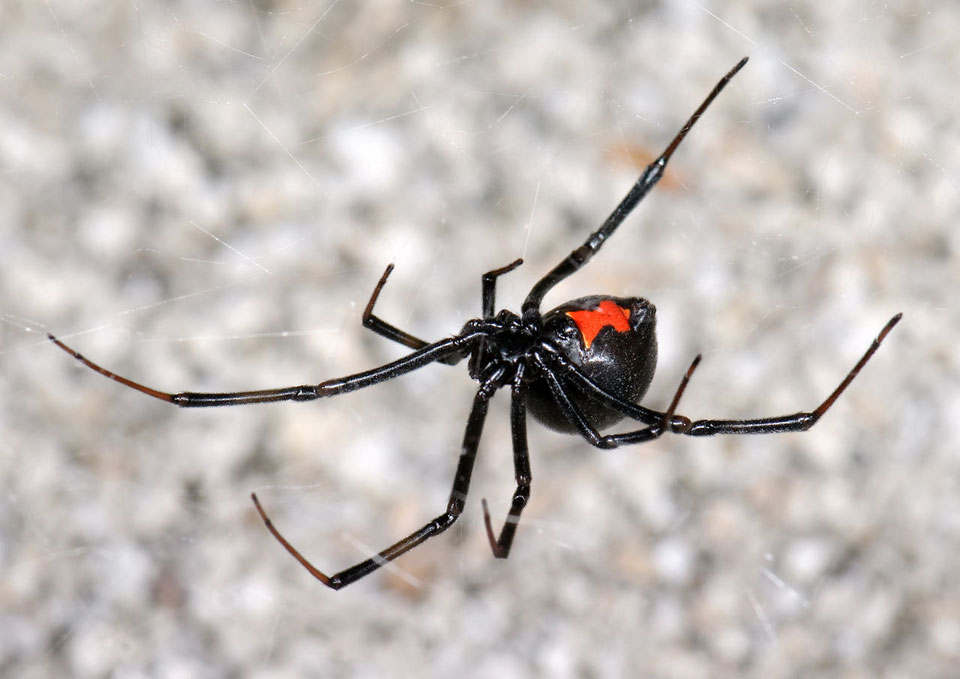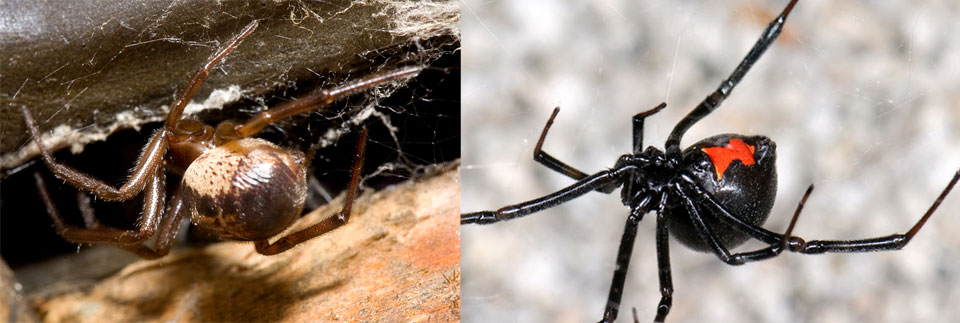The ‘true widow’ spiders are from the genus Latrodectus. There are around 30 species in this group but by far the best known is the black widow spider (although this includes more than one species).

The black widows are characterised by their glossy black colour and large round abdomens with a red hourglass pattern on the underside. The widow spiders are approximately the same size as the false widows, having a body length of around 15mm and a total leg span of up to 35mm. All the black widow spiders are also capable of inflicting a painful bite that is potentially fatal to humans.
These spiders are found in warm dry habitats all over the world but are perhaps best known from the species found in the western USA and the redback spider found in Australia. They are not native to the UK and despite the occasional spider hitching a ride on a boat or plane they have never become established. The weather in Britain is simply to cold and damp.
The name ‘widow’ comes from the reported practice of the female spider of some species eating the smaller male as a post-sex snack! However, this activity has only been seen in a few species and this has generally been in confined laboratory conditions.
What is certain is the female’s venom is much more potent than that of the male; at least 3 times so.
The black widow spider bite
The black widow’s venom is highly toxic, second only in strength to the Brazilian wandering spider. Only 0.05mg of the venom can be fatal to a human and 36 deaths were attributed to black widow bites the USA alone between 1965 and 1990.
The venom is a nuerotoxin known as latrotoxin and results in the system wide condition of latrodectism in around 25% of bites. Symptoms include raised blood pressure, abdominal cramp, generalized muscle pains, extreme sweating, rapid heart beat / palpitations and even temporary paralysis. These symptoms last for around 3 to 7 days but in some cases some effects may continue for several weeks.
In general the severity of a bite will depend on how much venom has been injected. The victim can expect to feel a pinprick pain followed by a burning sensation. The pain worsens with time and may spread. If the venom enters the blood stream it can act on the nerves causing muscle cramps either locally or in many cases painful abdominal cramping. If latrodectism does not occur most people recover within a matter of hours or days without specific treatment.
In the worse cases an anti-venom is available. This has its own associated risks of provoking an allergic reaction so is not given generally.
False widow vs black widow

The false widow spiders (Steatoda) are quite closely related to the widow spiders (Latrodectus) and there are definite similarities. The size and shape along with the glossy appearance for starters. So on initial inspection it wouldn’t be impossible to confuse one for the other. Where the spiders differ is in their colouration and markings; the false widows have an orangey brown thorax and legs whereas the true widows are black. The markings on the abdomen also differ with the classic black widow having a distinct red hourglass marking on the underside compared with false widows having various cream coloured markings on the top of the abdomen.
There are however considerable variations between individuals in both species with some true widows being lighter in colour so confusion is still possible. Both species also create similar tangled webs.
The true test is in the bite. If it hurts it’s probably a false widow. If it really, really hurts then it may well be a black widow!